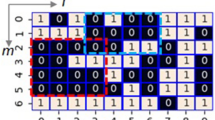Abstract
The one person–one vote principle for political redistricting requires balancing populations across districts. We address the matter of simultaneously balancing a second attribute across districts, proving that this is always possible to within reasonable tolerances. Feasibility is demonstrated by formulating the problem as a constrained partitioning problem on graphs. The resulting computational results demonstrate the practicality of obtaining dual-balanced districts whose balance for both attributes is well within reasonable deviations from the ideal values. Applications include attempts to avoid differential population growth leading to malapportionment between decennial census counts or simultaneously balancing total and voting-age populations.





Similar content being viewed by others
Data availability
The raw data used in this paper is publicly available from [20, 21] and https://redistrictingdatahub.org. Replication code for the empirical experiments is available at [14].
Notes
This is sometimes referred to as “eligible-voter” redistricting where the plans are balanced according to citizen, voting-age population, or CVAP.
References
AAJC, MALDEF, and National Conference on Citizenship (Organizers): Statement on Appropriate Data for Redistricting, https://www.advancingjustice-aajc.org/sites/default/files/2021-04/Statement%20on%20Appropriate%20Data%20for%20Redistricting%20FINAL%204.27.2021.pdf, (2021).
Alexeev, Boris, & Mixon, Dustin G. (2018). Partisan gerrymandering with geographically compact districts. Journal of Applied Probability, 55(4), 1046–1059. https://doi.org/10.1017/jpr.2018.70
Badger, E.: People Who Can’t Vote Still Count Politically in America. What if That Changes?, New York Times Upshot, (2019).
Bar-Natan, A., Najt, L., & Schutzman, Z. (2020). The gerrymandering jumble: map projections permute districts’ compactness scores. Cartography and Geographic Information Science, 47(4), 321–335.
Barnes, R., & Solomon, J. (2021). Gerrymandering and Compactness: Implementation Flexibility and Abuse. Political Analysis, 29(4), 448–466.
Becker, A., & Gold, D. (2022). The gameability of redistricting criteria. Journal of Computational Social Science, 5, 1735–1777.
Bernstein, M., & Duchin, M. (2017). A formula goes to court: Partisan gerrymandering and the efficiency gap. Notices of the American Mathematical Society, 64(9), 1020–1024.
Bespamyatnikh, S., Kirkpatrick, D., & Snoeyink, J. (2000). Generalizing ham sandwich cuts to equitable subdivisions. Discrete and Computational Geometry, 24(4), 605–622.
Boland, J., Rudensky, Y., & Li, M. (2021). Why States Should Wait for Census Data to Draw Voting Districts , Brennan Center for Justice Report, https://www.brennancenter.org/media/7532/download,
Chen, Jowei, & Stephanopoulos, Nicholas. (2021). Democracy’s Denominator. California Law Review, 109, 1019–1065.
DeFord, D., Dhamankar, N., Duchin, M., Gupta, V., McPike, M., Schoenbach, G., & Sim, K. (2021). Implementing partisan symmetry: Problems and paradoxes, Political Analysis, 1-20.
DeFord, D., Duchin, D., & Solomon, J. (2020). A computational approach to measuring vote elasticity and competitiveness. Statistics and Public Policy, 7(1), 69–86.
DeFord, D., Duchin, D., & Solomon, J. (2021). ReCombination: A family of Markov chains for redistricting, Harvard Data Science Review, 3(1),
Deford, D., Kimsey, E., & Zerr, R. (2022). Replication Data and Code for WA experiments in “Multi-Balanced Redistricting”, https://github.com/drdeford/MBR_WA.
Duchin, M., & Tenner, B. E. (2018). Discrete geometry for electoral geography, arXiv:1808.05860.
Edelman, P. H. (2016). Evenwel, Voting Power, and Dual Districting. Journal of Legal Studies, 45(1), 203–221.
Hirsch, S. (2003). The United States House of Unrepresentatives: What Went Wrong in the Latest Round of Congressional Redistricting. Election Law Journal, 2(2), 179–216.
Kaneko, A., & Kano, M. (1999). Balanced partitions of two sets of points in the plane. Computational Geometry: Theory and Applications, 13, 253–261.
Katz, J., King, G., & Rosenblatt, E. (2020). Theoretical Foundations and Empirical Evaluations of Partisan Fairness in District-Based Democracies. American Political Science Review, 114(1), 164–178.
Manson, S., Schroeder, J., Van Riper, D., Kugler, T., & Ruggles, S. (2021). IPUMS National Historical Geographic Information System: Version 16.0 [dataset], Minneapolis, MN: IPUMS. https://doi.org/10.18128/D050.V16.0
NDSU Center for Social Research: ND Compass: State Legislative District Profiles, available at https://www.ndcompass.org/legislative-district-profiles/, accessed on 23 May 2021.
Rudensky, Y., Li, M., & Lìmon, G. (2021). The Impact of Census Timeline Changes on the Next Round of Redistricting, Brennan Center for Justice Report, https://www.brennancenter.org/media/7532/download
Sakai, T. (2002). Balanced convex partitions of measures in \(\mathbb{R} ^n\). Graphs Combin., 18(1), 169–192.
Soberón, P. (2017). Gerrymandering, sandwiches, and topology. Notices of the American Mathematical Society, 64(9), 1010–1013.
Stephanopoulos, Nicholas, & McGhee, Eric. (2015). Partisan Gerrymandering and the Efficiency Gap. University of Chicago Law Review, 82, 831–900.
Ueckerdt, T. (2021). Lecture Notes: Combinatorics in the Plane, available at https://www.math.kit.edu/iag6/lehre/combplane2013s/media/lecture_notes.pdf, accessed on 21 May
Washington State Legislature: Rules Code of Washington: 44.05.140 Residence of certain individuals-Last known place of residence., https://app.leg.wa.gov/Rcw/default.aspx?cite=44.05.140, accessed May 11, 2023.
Acknowledgements
E. K. was supported by the Ellen Hauge Abelson Scholarship for undergraduate research from the Washington State University College of Arts and Sciences.
Author information
Authors and Affiliations
Corresponding author
Ethics declarations
Conflict of interest
D. D. has previously served as an expert in redistricting cases. E. K. and R. Z. have no conflicts to report.
Additional information
Publisher's Note
Springer Nature remains neutral with regard to jurisdictional claims in published maps and institutional affiliations.
D. DeFord: https://scholar.google.com/citations?user=nE14CxwAAAAJ&hl=en.
Rights and permissions
Springer Nature or its licensor (e.g. a society or other partner) holds exclusive rights to this article under a publishing agreement with the author(s) or other rightsholder(s); author self-archiving of the accepted manuscript version of this article is solely governed by the terms of such publishing agreement and applicable law.
About this article
Cite this article
DeFord, D., Kimsey, E. & Zerr, R. Multi-balanced redistricting. J Comput Soc Sc 6, 923–941 (2023). https://doi.org/10.1007/s42001-023-00217-8
Received:
Accepted:
Published:
Issue Date:
DOI: https://doi.org/10.1007/s42001-023-00217-8




